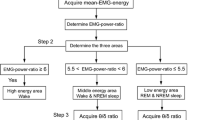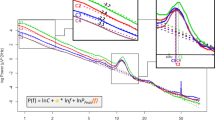Summary
-
1.
Sleep was studied in the diurnal rodentEutamias sibiricus, chronically implanted with EEG and EMG electrodes. Analysis of the distribution of wakefulness, nonrapid eye movement (NREM) sleep, and rapid eye movement (REM) sleep over the 24 h period (LD 12∶12) showed that total sleep time was 27.5% of recording time during the 12 h light period and 74.4% during the 12 h dark period. Spectral analysis of the sleep EEG revealed a progressive decay in delta power density in NREM sleep during darkness. Power density of the higher frequencies increased at the end of darkness. Power density of the higher frequencies decreased and that of the lower frequencies increased during light.
-
2.
Analysis of the distribution of vigilance states under three different photoperiods (LD 18∶6; 12∶12; 6∶18) revealed that changes in daylength mainly resulted in a redistribution of sleep and wakefulness over light and darkness. Under long days the percentage of sleep during light was enhanced. The time course of delta power density in NREM sleep was characterized by a long rising part and a short falling part under long days, while a reversed picture emerged under short days. As a consequence, the power density during light was relatively high under long days.
-
3.
After 24 h sleep deprivation by forced activity, no significant changes in the percentage of wakefulness and NREM were observed, whereas REM sleep was slightly enhanced. EEG power density, however, was significantly increased by ca. 50% in the 1.25–10.0 Hz range in the first 3 h of recovery sleep. This increase gradually decayed over the recovery night.
-
4.
The same 24 h sleep deprivation technique led to a ca. 25% increase in oxygen consumption during recovery nights. While the results of the EEG spectral analysis are compatible with the hypothesis that delta power density reflects the ‘intensity’ of NREM sleep as enhanced by prior wakefulness and reduced by prior sleep, such enhanced sleep depth after sleep deprivation is not associated with reduced energy expenditure as might be anticipated by some energy conservation hypotheses on sleep function.
Similar content being viewed by others
Abbreviations
- EEG :
-
electroencephalogram
- EMG :
-
electromyogram
- MUA :
-
multiple unit activity
- NREM :
-
non-rapid eye movement
- REM :
-
rapid eye movement
- SCN :
-
suprachiasmatic nucleus
- SWA :
-
slow wave activity
- TST :
-
total sleep time
- W :
-
wakefulness
References
Berger RJ (1984) Slow wave sleep, shallow torpor and hibernation: Homologous states of diminished metabolism and body temperature. Biol Psychol 19:305–326
Borbély AA (1982) A two process model of sleep regulation. Human Neurobiol 1:195–204
Borbély AA, Neuhaus HU (1978) Daily pattern of sleep, motor activity and feeding in the rat: effects of regular and gradually extended photoperiods. J Comp Physiol 124:1–14
Borbély AA, Neuhaus HU (1979) Sleep-deprivation: effect on sleep and EEG in the rat. J Comp Physiol 133:71–87
Borbély AA, Baumann F, Brandeis D, Strauch I, Lehmann D (1981) Sleep deprivation: effect on sleep stages and EEG power density in man. Electroencephalogr Clin Neurophysiol 51:483–493
Borbély AA, Tobler I, Hanagasioglu M (1984) Effect of sleep deprivation on sleep and EEG power spectra in the rat. Behav Brain Res 14:171–182
Brebbia DR, Altschuler KZ (1965) Oxygen consumption rate and electroencephalographic stages of sleep. Science 150:1621–1623
Campbell S, Tobler I (1984) Animal sleep: a review of sleep duration across phylogeny. Neurosci Biobehav Rev 8:269–300
Daan S, Aschoff J (1975) Circadian rhythms of locomotor activity in captive birds and mammals: their variation with season and latitude. Oecologia 18:269–316
Daan S, Beersma DGM, Borbély AA (1984) Timing of human sleep: recovery process gated by a circadian pacemaker. Am J Physiol 246:R161-R178
Dijk DJ, Beersma DGM, Daan S (1987a) EEG power density during nap sleep: reflection of an hourglass measuring the duration of prior wakefulness. J Biol Rhythms 2:207–219
Dijk DJ, Beersma DGM, Daan S, Bloem GM, van den Hoofdakker RH (1987b) Quantitative analysis of the effects of slow wave sleep deprivation during the first 3 h of sleep on subsequent EEG power density. Eur Arch Psychiatr Neurol Sci 236:323–328
Estep D, Canney E, Cochran C, Hunter J (1978) Components of activity and sleep in two species of chipmunks:Tamias striatus andEutamias dorsalis. Bull Psychon Soc 12:341–343
Frederickson CJ, Rechtschaffen A (1978) Effects of sleep deprivation on awakening thresholds and sensory evoked potentials in the rat. Sleep 1:69–82
Friedman L, Bergmann B, Rechtschaffen A (1979) Effects of sleep deprivation on sleepiness, sleep intensity, and subsequent sleep in the rat. Sleep 1:369–391
Grahnstedt S, Ursin R (1980) Awakening thresholds for electrical brain stimulation in five sleep-waking stages in the cat. Electroencephalogr Clin Neurophysiol 48:222–229
Hill RW (1972) Determination of oxygen consumption by use of the paramagnetic oxygen analyser. J Appl Physiol 33:261–263
Hoban TM, Sulzman FM (1985) Light effects on circadian timing system of a diurnal primate, the squirrel monkey. Am J Physiol 18:R274-R280
Inouye ST, Kawamura H (1979) Persistence of circadian rhythmicity in mammalian hypothalamic island containing the suprachiasmatic nucleus. Proc Natl Acad Sci USA 76:5962–5966
Mendelson WB, Vaughn WJ, Walsh MJ, Wyatt RJ (1980) A signal analysis approach to rat sleep scoring instrumentation. Waking and Sleeping 4:1–8
Pittendrigh CS, Daan S (1976) A functional analysis of circadian pacemakers in nocturnal rodents V. Pacemaker structure: a clock for all seasons. J Comp Physiol 106:333–355
Pohl H (1972) Die Aktivitätsperiodik von zwei tagaktiven Nagern,Funambulus palmarum undEutamias sibiricus unter Dauerlichtbedingungen. J Comp Physiol 78:60–74
Pohl H (1976) Proportional effect of light on entrained circadian rhythms of birds and mammals. J Comp Physiol 112:103–108
Pohl H (1982) Characteristics and variability in entrainment of circadian rhythms to light in diurnal rodents. In: Aschoff J, Daan S, Groos GA (eds) Vertebrate circadian systems, structure and physiology. Springer, Berlin Heidelberg New York, pp 339–346
Rabiner ER, Gold B (1975) Theory and application of digital signal processing. Prentice Hall, Englewood Cliffs, NJ
Ramm P, Frost BJ (1986) Cerebral and local cerebral metabolism in the cat during slow wave sleep and REM sleep. Brain Res 365:112–124
Rosenberg RS, Bergmann BM, Rechtschaffen A (1976) Variations in slow wave activity during sleep in the rat. Physiol Behav 17:931–938
Rusak B, Zucker I (1979) Neural regulation of circadian rhythms. Physiol Rev 59:494–526
Sato T, Kawamura H (1984a) Effects of bilateral suprachiasmatic nucleus lesions on the circadian rhythms in a diurnal rodent, the Siberian chipmunk (Eutamias sibiricus). J Comp Physiol A 155:745–752
Sato T, Kawamura H (1984b) Circadian rhythms in multiple unit activity inside and outside the suprachiasmatic nuclei in the diurnal chipmunk (Eutamias sibiricus) Neurosci Res 1:45–52
Tobler I, Borbély AA (1986) Sleep EEG in the rat as a function of prior waking. Electroencephalogr Clin Neurophysiol 64:74–76
Tobler I, Jaggi K (1987) Sleep and EEG spectra in the Syrian hamster (Mesocricetus auratus) under baseline conditions and following sleep deprivation. J Comp Physiol A 161:449–459
Tobler I, Murison R, Ursin R, Ursin H, Borbély AA (1983) The effect of sleep deprivation and recovery sleep on plasma corticosterone in the rat. Neurosci Lett 35:297–300
Trachsel L, Tobler I, Borbély AA (1986) Sleep regulation in rats: effects of sleep deprivation, light and circadian phase. Am J Physiol 251:R1037-R1044
Trachsel L, Tobler I, Borbély AA (1988) Electroencephalogram analysis of non-rapid eye movement sleep in rats. Am J Physiol 255:R27-R37
Van Luijtelaar ELJM, Coenen AML (1984) An EEG averaging technique for automated sleep-wake stage identification in the rat. Physiol Behav 33:837–841
Zepelin H, Rechtschaffen A (1974) Mammalian sleep, longevity and energy metabolism. Brain Behav Evol 10:425–470
Author information
Authors and Affiliations
Rights and permissions
About this article
Cite this article
Dijk, D.J., Daan, S. Sleep EEG spectral analysis in a diurnal rodent:Eutamias sibiricus . J. Comp. Physiol. 165, 205–215 (1989). https://doi.org/10.1007/BF00619195
Accepted:
Issue Date:
DOI: https://doi.org/10.1007/BF00619195




